|

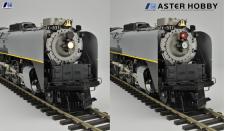


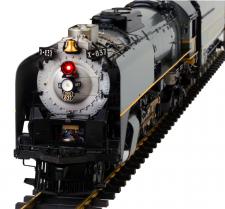

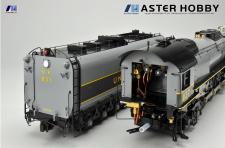
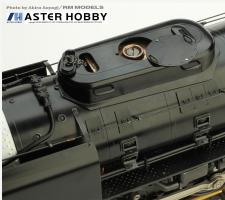
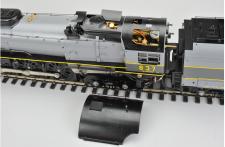
|
Union Pacific FEF History
In December 1926 the American Locomotive Company ∪ALCO∩ delivered the first of 12 locomotives with a 4-8-4 wheel arrangement to the Northern Pacific Railroad. When trying to describe these new engines, NP officials decided to call them the ∪Northern∩ type. This description was later widely accepted by most roads, however, a few others like the NYC Railroad decided to call them ∪Niagara∏s∩, the Lackawanna designated them as ∪Poconos∩, the C&O named theirs ∪Greenbrier∏s∩ and the RF&P called them ∪Governors∩. The 4-8-4 evolved to be the ultimate development of non articulated steam power and became the standard modern American steam locomotive. All major US Railroads used them and a total of 1125 units were built, the last one # 613 for the Norfolk &Western in 1950.
The Union Pacific ordered the first 4-8-4∏s from ALCO in 1936 and designated them simply as ∪FEF∏s∩, which was short for four- eight- four. The entire production series was also often referred to as the ∪eight hundreds∩ since all UP FEF∏s were numbered in the 800 sequence.
The UP 800 series evolved from shortcomings of older steam power such as the 4-8-2 ∪Mountain∩ types which had been pulling the top UP passenger trains for over a decade. Increasing speed and load demands of the post-depression era demanded new pulling power. UP president William Jeffers demanded the acquisition of new locomotives which had the horsepower to pull a 16 coach Heavy weight train between Omaha NE and Cheyenne WY unassisted at max. speed of 70 miles/hr. without service stops. Otto Jabelmann and his team evaluated existing 4-8-4 designs and applied improvements deemed necessary to fulfill the demands required on the UP road. When UP officials visited ALCO in Schenectady NY to review the design, ALCO engineers accepted and within only nine months, in September of 1936, the first locomotive of 20 ordered was delivered.
The FEF-1
The initial 20 engines were numbered 800-819 and after brief test and brake-in runs with freight drags, placed into passenger service. The FEF1∏s had 77inch drive wheels and an operating weight of 465∏000 lbs. The 6-axle tender∏s weight 366∏000 lbs. Tractive force was rated at 63∏600 lbs. Maximum boiler pressure was 300 PSI. The FEF1∏s were equipped with a single smoke stack and twin exhaust blast nozzles. The steaming capacity of the boiler was almost inexhaustible and one of the greatest attributes to the design. The superheater surface of 1535 square feet provided steam temperatures of 750 Fahrenheit or better. The locomotives easily exceeded their projected operating speeds of 70 miles/hr. reaching 90 miles/hr. without problems. The FEF1∏s proved better in operation than was originally anticipated and UP decided to order additional units.
The FEF-2
The second order to ALCO was for 15 locomotives numbered 820-834. These were even more a UP creation than the first batch with design improvements credited to the inspired engineering staff under the leadership of Otto Jabelmann, often referred to as the father of the 800∏s, Challengers and Big Boys. Increasing the drive wheel diameter to 80 inches and redesigning the piston and drive rods was one of many improvements to reduce possible stress failure and increase sustained speeds of 90 miles/hr. The smoke box was modified to economize fuel consumption and cylinder diameter was increased by 2 inches. The twin exhaust blast nozzle was replaced with a four jet unit while the single exhaust stack was still retained. Probably the most notable change was a newly designed larger 7 axle tender to avoid running short of water with heavier trains. These tenders became known as ∪centipede tenders∩ carrying 23∏500 gallons of water and 25 tons of coal. The operating weight of a FEF2 was 483∏000 lbs. with a tractive force of 63∏800 lbs. The loaded ∪centipede tender∩ weighed 406∏500 lbs.
The FEF-3
World War II was directly responsible for the acquisition of the 3rd series of 10 additional FEF∏s.
As the European war came to a close and shifted to the Pacific Rim, the war department projected an increase in westbound railroad traffic by 25%. In the summer of 1944, the Union Pacific received approval from the War Production Board for 10 additional locomotives. These were numbered 835-844. Diesel locomotives built by General Motors Electro Motive Division (EMD) started to replace main line steam in 1937and the UP would have never considered ordering 10 more steam engines if the War Production Board had not granted priority for diesel engine production to the US Navy which demanded most of EMD∏s production capacity. The final 10 FEF3∏s again featured many improvements over the 2nd series but looked almost identical in appearance. The most noticeable change was the twin stack exhaust and feedwater heater in front of the exhaust stack shroud. A new twin exhaust blast manifold with four blast nozzles each further improved steaming power. Hollow piston rods were installed with redesigned and lightened side rods to reduce reciprocating forces at high speeds. An unforeseen problem resulted from the new twin exhaust stack design which reduced back pressure in the smoke box but caused exhaust smoke drifting, especially when operating under low power or during downhill runs. This led to the installation of smoke lifter panels, which had proven useful with other roads, primarily the NYC and Boston & Maine.
FEF Locomotive 840 was chosen for smoke wing development and testing at Archer Hill until the optimal wing configuration was established. Within two years all FEF 2∏s and 3∏s were equipped with smoke wings, and by 1950 some of the early 800∏s still in service had them installed.
The FEF∏s had established a supreme operations record and were considered masterpieces of design producing between 4100 - 4500 horsepower. They operated flawlessly in long haul assignments up to 1390 miles distance over the vast UP rail network. The usual mileage accumulated in regular service was around 14∏000 miles per month. The average accumulated distance before turning the drivers was close to 130∏000 miles. ∪Cinder abrasion∩ during the coal-fired period required flue replacement around 200∏000 miles. This was later increased with oil firing to 300∏000 miles.
Train assignments for the 800∏s were the ∪Portland Rose∩, ∪Pacific Limited∩, ∪Overland Limited∩, ∩National Parks Special∩, ∪The Gold Coast∩, ∪ Transcon∩, ∪Los Angeles Challenger∩ to name just a few, as well as troop trains, express mail, and perishable merchandise specials. After the end of the war, all FEF∏s were converted from coal to oil firing. A new safety requirement in certain operating divisions mandated installation of a red safety light above the standard headlight. This red light was activated in emergencies and during servicing and station stops.
One of the more remembered changes was the two-tone gray paint scheme applied in 1946 to match the gray Pullman Standard coaches built between 1941 and 1946. FEF # 809 was the first to receive the two-tone gray paint with silver striping. During this program and with dieselization already in progress, UP acquired new yellow streamline coaches. The passenger department officials suggested that all gray locomotives should feature yellow striping to closer match the new coaches. The yellow striping was immediately applied during regular locomotive shopping schedules. By 1952 diesels had replaced all steam in passenger service and all FEF∏s went back to black livery. By the end of the 1950∏s, steam operations ended and Locomotive # 844, the last of the 800 series, was singled out for experimental snow melting duties. This saved the locomotive from the scrap line. #844 was first stored in North Platt with other significant steam icons, then later moved to Cheyenne to be preserved in operating condition for steam excursion specials under the Union Pacific Heritage program. Locomotive FEF3 # 844 together with preserved Challenger #3984 are reminders of the railroad∏s role in industrializing the North American continent across the vast distances of the central plains to the west coast.
Aster Hobby Co. Inc. of Yokohama Japan, assisted by Hans Huwyler of Aster Hobby USA LLC, have designed and produced two live steam versions of this historic locomotive series in black and gray livery for your enjoyment. If you∏re already the lucky owner of the Aster UP Big Boy and UP Challenger, the FEF3 will further enhance your collection of these famous icons of the American steam era.
Editorial by Hans Huwyler AH USA LLC
Historical contents quoted from publications:
∪The Mighty 800∩ by WM.W. Kratville
∪The History of the Union Pacific Railroad in Cheyenne∩ by Robert Darwin.
∪Guide to North American Steam locomotives∩ by George H. Drury
| Scale/Gauge |
1/32 Gauge one (45 mm) |
| Weight |
14.0 kg/dry.( 10 kg + 4 kg/dry.) |
| Length |
1100mm (Engine660mm + tender 460mm) |
| Width |
110mm |
| Height |
165mm |
| Wheel Arrangement |
4≥8≥4 NORTHERN |
| Driving Wheel |
63.5mm |
| Pilot and Trailer Truck Wheel |
33mm |
| Tender Truck Wheel |
33mm |
| Axle Driven Pump |
Φ6mm X 24mm |
| Cylinder |
dia15mm X 24mm |
| Valve Gear |
Walschaert |
| Boiler Type |
C TYPE |
| Water Capacity |
800 cc/100% full |
| Boiler Fittings |
Super heater, Opening fire door, Gauge glass, Pressure gauge, Blower valve, Gauge glass blow-down valve, By-pass valve, Twin safety valves, Whistle, Boiler blow-down valve |
| Lubricator |
Roscoe Displacement Type |
| Tender |
Hand operation pump ∈BORE 11 mm ∵ STROKE 12 mm∷ Water drain plug, 7 axles with coil springs, Fuel tank removable, RC battery compartment, Water cap, Fuel line shut off valve |
Water Tank Capacity
|
1000 ml |
Fuel
|
Methylated alcohol |
| Fuel Capacity |
600 ml |
| Minimum Radius |
3m |
|